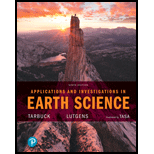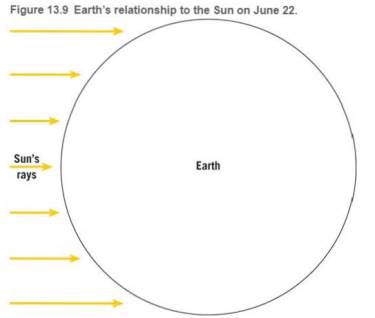
Applications and Investigations in Earth Science (9th Edition)
9th Edition
ISBN: 9780134746241
Author: Edward J. Tarbuck, Frederick K. Lutgens, Dennis G. Tasa
Publisher: PEARSON
expand_more
expand_more
format_list_bulleted
Textbook Question
Chapter 13, Problem 5LR
Complete Figure 13.9, showing Earth’s relationship to the Sun on June 22. Sketch and label the following on Earth:

| Axis |
| Equator |
| Tropic of Cancer |
| Tropic of Capricorn |
| Antarctic Circle |
| Arctic Circle |
| Circle of illumination |
| Location of the overhead noon Sun |
Expert Solution & Answer
Learn your wayIncludes step-by-step video

schedule08:45
Students have asked these similar questions
Why might drought actually cause fire risk to reduce in a desert area?
Part 1: A completely saturated sample of sandstone has a bulk density of 2.61 g/cm³, an
effective porosity of 10 percent, and a total porosity of 12 percent.
Determine the density of the solid phase (i.e., the density of the mineral).
Part 2: One cubic meter of quartz sand has a dry mass of 2,320 kg.
a) Calculate the porosity of the sand.
b) Calculate the mass (in kg) of the sand for the following degrees of saturation:
25 percent, 75 percent, 100 percent.
Part 3: A sample of quartz sand has a dry mass of 753.7 kg and a volume of 0.36 m³.
a) Calculate the porosity of the sand.
b) Calculate the mass (in kg) of the sand assuming a degree of saturation equal to
62 percent.
What is an oxbow lake and how is it formed?
Chapter 13 Solutions
Applications and Investigations in Earth Science (9th Edition)
Ch. 13.1 - Prob. 1ACh. 13.1 - Prob. 2ACh. 13.1 - Prob. 3ACh. 13.1 - Prob. 4ACh. 13.1 - Prob. 5ACh. 13.1 - Prob. 6ACh. 13.1 - Assume that the length of line X-Y represents 100...Ch. 13.1 - Prob. 8ACh. 13.1 - Prob. 9ACh. 13.1 - Prob. 10A
Ch. 13.2 - Prob. 1ACh. 13.2 - Use Figure 13.4, which shows the position of Earth...Ch. 13.2 - Which name season is used to describe the June...Ch. 13.2 - On June 21-22, are the Suns noon rays directly...Ch. 13.2 - What latitude receives the most intense solar...Ch. 13.2 - Would you look.toward the north or south to see...Ch. 13.2 - Use the circle of illumination on the globe...Ch. 13.2 - Using Table 13.1, provide the length of daylight...Ch. 13.2 - What name season is used to describe the December...Ch. 13.2 - At which parallel of latitude-the Tropic of...Ch. 13.2 - Prob. 11ACh. 13.2 - If you lived at the equator on December 21- 22,...Ch. 13.2 - Prob. 13ACh. 13.2 - Prob. 14ACh. 13.2 - Prob. 15ACh. 13.2 - Prob. 16ACh. 13.2 - Prob. 17ACh. 13.2 - Prob. 18ACh. 13.2 - Prob. 19ACh. 13.2 - Prob. 20ACh. 13.3 - Prob. 1ACh. 13.3 - Prob. 2ACh. 13.3 - Prob. 3ACh. 13.3 - Prob. 4ACh. 13.3 - Prob. 5ACh. 13.4 - Prob. 1ACh. 13.4 - Prob. 2ACh. 13.4 - Prob. 3ACh. 13.4 - Prob. 4ACh. 13.4 - Prob. 5ACh. 13.4 - Prob. 6ACh. 13.5 - Prob. 1ACh. 13.5 - Prob. 2ACh. 13.6 - Prob. 1ACh. 13.6 - Prob. 2ACh. 13.6 - Prob. 3ACh. 13.6 - Prob. 4ACh. 13.6 - Prob. 5ACh. 13 - Prob. 1LRCh. 13 - How many hours of daylight occur at the following...Ch. 13 - During the winter solstice in the Northern...Ch. 13 - What is the relationship between the angle of the...Ch. 13 - Complete Figure 13.9, showing Earths relationship...Ch. 13 - What causes the intensity and duration of solar...Ch. 13 - What are the maximum and minimum noon Sun angles...Ch. 13 - What are the approximate maximum and minimum...Ch. 13 - Briefly describe how the intensity and duration of...Ch. 13 - On March 22, you view the noon Sun to the south at...Ch. 13 - What is the date illustrated by the diagram in...Ch. 13 - Calculate the noon Sun angle at 30N latitude on...
Additional Science Textbook Solutions
Find more solutions based on key concepts
The way to keep track of compounds in the solution needs to be explained. Concept introduction: Solutions are t...
Living By Chemistry: First Edition Textbook
3. The square and circle in FIGURE Q24.3 are in the same uniform field. The diameter of the circle equals the e...
Physics for Scientists and Engineers: A Strategic Approach, Vol. 1 (Chs 1-21) (4th Edition)
Distinguish between microevolution, speciation, and macroevolution.
Campbell Essential Biology (7th Edition)
Why are mutants used as test organisms in the Ames test?
Laboratory Experiments in Microbiology (12th Edition) (What's New in Microbiology)
What global policy changes and what individual choices can help us sustain the planet that sustains us?
Biology: Life on Earth with Physiology (11th Edition)
What terms are used to describe organisms whose growth pH optimum is very high? Very low?
Brock Biology of Microorganisms (15th Edition)
Knowledge Booster
Similar questions
- For the past 3 million years the earth has experienced glacial-interglacial cycles at regular intervals that coincide with the Milankovitch Cycles. Please briefly describe the three Milankovitch Cycles and their timescales. What is the leading theory for why the timing of glacial-interglacial cycles is connected to these Milankovitch Cycles?arrow_forwardWhy do waterfalls move backwards over time? In your explanation, please use the term “nickpoint”?arrow_forwardThe picture below is of the Kaskawulsh Glacier in Yukon, Canada. What is the name of the type of feature that the red arrows are pointing to in the middle of the glacier and how are these features formed? In your answer please also define the term lateral moraine and how lateral moraines relate to the feature with the red arrows?arrow_forward
- it was stated that one major effect of rivers is to flatten out the continents. How do rivers flatten continents?arrow_forwardThe figure below shows the average change in glacier mass per unit area for various mountainous regions around the world. Why are the globe’s mountain glaciers shrinking? Does glacial melt increase or decrease the amount of water stored on the continents? What are the factors in the continental water budget equation that must change in order to restore equilibrium when glaciers melt ? What is the effect on global sea level?arrow_forwardWhat is continental precipitation recycling ?Using the concept of precipitation, please explain why changes in landcover in one place can feed back to impact the climate not only in the area where the landcover change occurred but also in other regions?arrow_forward
- In the western United States, does severe forest fire tend to increase or decrease streamflow? What are the two main reasons hypothesized to cause this effect?arrow_forwardForest-fire sizes in the western US have grown rapidly in recent decades. made the case that this was not due to increased human population and resultant human-caused ignitions. What was the main evidence for this?arrow_forwardDraw a cross section with a tree growing out of Earth’s surface (so I know which side is the surface). Add a dipping joint and label the hanging wall and footwall blocks. Draw a second cross section (again with a tree on the surface of the Earth) that shows how Earth’s surface would be offset along this joint if it turned into a normal fault. Label the hanging wall and footwall and use arrows to indicate the motion of the hanging wall relative to the footwall. Now draw a third cross section with all the same elements as in parts A and B, but for a trust/reverse fault. Imagine the same cross section either in three dimensions, or in a bird’s-eye view from top down. Draw what this area would look like after a right-lateral strike-slip fault. Label the strike of the fault and use arrows to show directions of movementarrow_forward
- Examine the strike and dip of the rock units on the Devil's Fence geologic map in Figure 6.21. Draw multiple large arrows on the map, pointing in the direction of dip on several rock units. Do the rock layers located near the center of the map in Section 14 dip toward the northwest or southeast? The same rocks in Section 14 are also found in Section 18. Do the rocks in Section 18 dip toward the east or west? What is the approximate angle of dip of the units in Section 18?arrow_forward1. Draw a dashed line representing the hinge line of the large geologic structure that occupies most of the map. Label the hinge line. 2. Are the rocks getting older or younger farther from the hinge line? 3. Is this geologic structure a plunging anticline or syncline? 4. Provide two lines of evidence that support your answer to Question 8.arrow_forwardOn the map in Figure 6.21, write the word oldest where the oldest sedimentary rock unit is exposed at the sur-face and the word youngest where the youngest sedimentary rocks occur.arrow_forward
arrow_back_ios
SEE MORE QUESTIONS
arrow_forward_ios
Recommended textbooks for you
 Applications and Investigations in Earth Science ...Earth ScienceISBN:9780134746241Author:Edward J. Tarbuck, Frederick K. Lutgens, Dennis G. TasaPublisher:PEARSON
Applications and Investigations in Earth Science ...Earth ScienceISBN:9780134746241Author:Edward J. Tarbuck, Frederick K. Lutgens, Dennis G. TasaPublisher:PEARSON Exercises for Weather & Climate (9th Edition)Earth ScienceISBN:9780134041360Author:Greg CarbonePublisher:PEARSON
Exercises for Weather & Climate (9th Edition)Earth ScienceISBN:9780134041360Author:Greg CarbonePublisher:PEARSON Environmental ScienceEarth ScienceISBN:9781260153125Author:William P Cunningham Prof., Mary Ann Cunningham ProfessorPublisher:McGraw-Hill Education
Environmental ScienceEarth ScienceISBN:9781260153125Author:William P Cunningham Prof., Mary Ann Cunningham ProfessorPublisher:McGraw-Hill Education Earth Science (15th Edition)Earth ScienceISBN:9780134543536Author:Edward J. Tarbuck, Frederick K. Lutgens, Dennis G. TasaPublisher:PEARSON
Earth Science (15th Edition)Earth ScienceISBN:9780134543536Author:Edward J. Tarbuck, Frederick K. Lutgens, Dennis G. TasaPublisher:PEARSON Environmental Science (MindTap Course List)Earth ScienceISBN:9781337569613Author:G. Tyler Miller, Scott SpoolmanPublisher:Cengage Learning
Environmental Science (MindTap Course List)Earth ScienceISBN:9781337569613Author:G. Tyler Miller, Scott SpoolmanPublisher:Cengage Learning Physical GeologyEarth ScienceISBN:9781259916823Author:Plummer, Charles C., CARLSON, Diane H., Hammersley, LisaPublisher:Mcgraw-hill Education,
Physical GeologyEarth ScienceISBN:9781259916823Author:Plummer, Charles C., CARLSON, Diane H., Hammersley, LisaPublisher:Mcgraw-hill Education,

Applications and Investigations in Earth Science ...
Earth Science
ISBN:9780134746241
Author:Edward J. Tarbuck, Frederick K. Lutgens, Dennis G. Tasa
Publisher:PEARSON

Exercises for Weather & Climate (9th Edition)
Earth Science
ISBN:9780134041360
Author:Greg Carbone
Publisher:PEARSON

Environmental Science
Earth Science
ISBN:9781260153125
Author:William P Cunningham Prof., Mary Ann Cunningham Professor
Publisher:McGraw-Hill Education

Earth Science (15th Edition)
Earth Science
ISBN:9780134543536
Author:Edward J. Tarbuck, Frederick K. Lutgens, Dennis G. Tasa
Publisher:PEARSON

Environmental Science (MindTap Course List)
Earth Science
ISBN:9781337569613
Author:G. Tyler Miller, Scott Spoolman
Publisher:Cengage Learning

Physical Geology
Earth Science
ISBN:9781259916823
Author:Plummer, Charles C., CARLSON, Diane H., Hammersley, Lisa
Publisher:Mcgraw-hill Education,